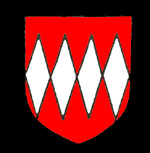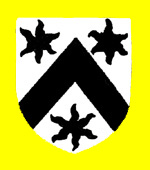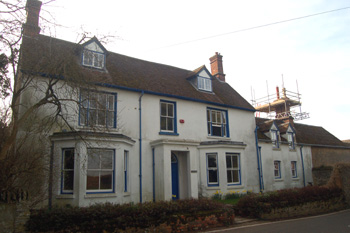Carlton Manors
This page has been written by volunteer Pamela Hider
Definition
According to the Manorial Documents Register Project (2013), a manor is "a piece of landed property with tenants, over whom the landlord exercised rights of jurisdiction in a private court...this means that if the records of a manorial court survive, or the history of the manor is extensively documented, it is considered as having been proved to exist. Other landholdings about which we are not so sure, will be considered unproven unless new evidence comes to light....Sometimes, after the dissolution of the monasteries, servants of the Crown and other families acquired land or part of an estate and referred to it as a manor, perhaps because they felt a manorial title would increase their status, even though legally, no new manors should have been created after 1290!".
Of course, manors could grow by acquisition of neighbouring land, conversely they could shrink, and further, old ones could be absorbed into larger manors. Manors ceased being recorded in 1670.
Some manors could also have aliases ie. the same manor but held by different people (who could give it their name) in the course of its history . Other manors could have the same name in the same parish and yet others could change names when divided between heirs.
Untangling the histories of individual manors is one thing; knowing whether an estate was actually a manor is another and earlier history is obscure. Against this background, we delve into the manors (or not) of Carlton in which there are two proved manors: Carlton Manor and Carlton (Mordaunt) Manor (Manorial Documents Register,National Archives); and who knows what evidence lies beneath of others!
Four properties and their owners were mentioned in the Domesday Survey of 1086 - none of which was a manor as such (VCHB). Also,during the 13th and 14th centuries, the Beauchamps of Bedford, among others, had an overlordship in Carlton, with many tenants including The Malherbes.The property was transferred to Harrold Priory in 1392 (VCHB).
The first of the proved manors can be dated to pre 1420:
Carlton Manor alias de Pabenham
The description of land held by Herbert, son of Ivo, referred to in the page on 'Early land ownership', is likely to be that which developed and attained manorial status under the de Pabenham family in the 13th century (they took their name from the neighbouring parish of Pavenham, where their main manorial holding was based from 1200 - 1414, and their descendants included Edward VI and Elizabeth I). In 1278, the enclosure of land had created a deer park (Birrell 1992) thus Carlton manor had included a park of 20 acres and woods known as Carlton Park and Pakenham Parke respectively, which was within the limits of the King's forest. The manor was first referred to as a manor in 1300 in the Testa (a listing of feudal landholdings). It remained in the de Pabenham family (and was known as Pabenham manor) until, through marriage, it passed to the Lucy family in 1420.

The Lucy family arms
Carlton Manor alias de Pabenham alias de Lucy
In 1495, it was sold by Edmund Lucy outside the family to John Fisher & John Taylor. In 1564, Thomas Lucy, probably a great grandson of Edmund, alienated (sold) the manor outside the family to Agnes Adams. This marked the end of the first proved Carlton Manor. Although it retained its name as Carlton Manor, it passed through several owners including:
1570 Thomas Adams
1594 William Goddard
1704 William Steph
1714 William Weald who sold it to Sir Rowland Alston of Odell in whose family it was held until the 20th century.

Arms of the de Albini or Daubeney family
A Second Manor also called Carlton Manor (unproven)
A Norman knight named Nigel de Albini (also known as Nigel D'Aubigny) came from a family involved in the Crusades. He was a landowner whose tenants held land later known as Carlton manor, which included a watermill. Like the rest of his estates, Carlton became part of the barony of Cainhoe whose descent is given in Clophill and was last mentioned there in 1428. By 1609 it was declared to be held of the King. In between times:
1330 Henry La Leigh (the La Leigh family were from nearby Thurleigh) had conveyed the manor (now so called) by fine to William de Stondon, parson of Carlton, and others.
1359 John La Leigh alienated the manor by fine to John Trailly.
1400 The parishes of both Carlton & Chellington were under the Traillys.
1428 John La Wolfe held the fee.
Eventually the manor found its way to the Vauxes of Harrowden.
A Third Manor called Carlton and Chellington (unproven)
1464 An inquisition stated that Sir William Vaux of Harrowden had held the manors of Carlton & Chellington since 1461, but by now they were in the King's hands (Edward IV). Sir William, a zealous Lancastrian, had been attainted after the battle of Towton in 1461 and was slain at Tewkesbury in 1471; his lands had been granted to Sir Ralph Hastings.
Sir William's son, Nicholas (who had been brought up with his sister in the household of Lady Margaret Beaufort) obtained a reversal of his father's attainder and restoration of his father's lands from Henry VII, who knighted him after the battle of Stoke in 1487.
1523 Nicholas was created Lord Vaux of Harrowden (first baron), but died the same year while still in possession of Carlton & Chellington. His son Thomas inherited.
1556 Thomas died and his son, William, succeeded to his titles and estates. (It was this William whose daughter-in-law Eliza hid the Jesuit priest Fr.J.Gerard at Harrowden Hall, Wellingborough).
1582 Possibly to find the money to pay fines for his recusancy (he was often imprisoned and famously harboured Edmund Campion), he combined with his son & heir Henry to sell the manors of Carlton & Chellington, along with the advowsons of both churches, to Lewis Lord Mordaunt. These manors then became our Fourth Manor called Carlton (Mordaunt) (proven) which followed the descent of Turvey.

Arms of the Lords Mordaunt
A Fifth Manor called Carlton Hall or Stayesmore (unproven)
This manor was first mentioned in 1528/29 when William Stayesmore died, seised of Carlton Manor, held by Nicholas Lord Vaux (who held Carlton & Chellington above). It is uncertain which of the following refers to Carlton Hall OR Stayesmore OR both.
1530 Held by John Stayesmore
1609 Property of Philip Dobbs, a recusant so heavily fined "and in default of which payment, two thirds of his manor at Carlton Hall was granted to Francis Duncombe for 41 years" (VCHB). When Philip died in 1611 he was "buried in the nightime" (ibid).
1640 John Mordaunt, 1st Earl of Peterborough (grandson of Lewis Lord Mordaunt) conveyed it by fine to Thomas Alston.
1670 Henry Mordaunt, 2nd Earl of Peterborough,again conveyed it to the same trustee.
At some time in the 1650s, the Bishop of Norwich, Edward Reynolds, had bought Carlton Hall from Sir Thomas Alston of Odell. It passed to his son, another Edward (Archdeacon of Norfolk & Rector of Northampton) who married Frances, niece of Sir Thomas. It was then settled on their son, a 3rd Edward on the occasion of his marriage to Susannah Halford in 1687. It is doubtful if the Reynolds ever lived at Carlton, their families being based in Leicestershire and Warwickshire.
1650s - 1736 The Boddington family lived at Carlton Hall as tenants of The Reynolds.
An indication of how different parts of this manor (and others) could change ownership is shown by a document of 1694 held by Beds. Archives & Records Service (X112/2). When Harrold bridge was in disrepair at this time, lords of several local manors shared the responsibility of repairing it. They were named as Henry Mordaunt, 2nd Earl of Peterborough by reason of his manors of Stagsden, Turvey and Chellington; Edward Reynolds, by reason of his manor of Carlton, and Charles Cutts (see below), by reason of his manor of Stayesmore.
1736 The Reynolds had run into financial difficulties and eventually, Carlton Hall was sold to the Executors of the Duke of Kent in 1764. Meanwhile......
1678 An 'F. Rainolds, Gentleman of Carlton', was forced to mortgage Stayesmore to Charles Cutts, Haberdasher of Covent Garden, London (BLARS GA/1181). Failing to pay this debt, the manor passed to Charles.
Charles sold the manor to Uriah Bithray, a native of Carlton, who died in 1747, leaving the property to his son Thomas.
1764 By now it had passed to Uriah's nephews Charles & William Bithray.
1765 Charles Bithray died and his brother William sold it to Thomas Palmer, a draper of Olney, Bucks., who himself died in 1769.
By 1773, Thomas’ nephew, another Thomas Palmer, had come of age to inherit (L3/53-54). He emigrated to Philadelphia, Pennsylvania where he too was a draper.
1786, through his attorney John Palmer Jnr. of Olney (another draper), he sold it to Thomas Battams of Turvey (GA 1844).
1805 He pulled down the manor house and erected a new one, it is thought on the same site. This stands in the village, known as Stayesmore Manor in the High Street.
1818 On the death of Thomas, his son Robert became the owner. Robert also owned large amounts of land in Carlton as well as in Haynes, Wilhampstead & Olney.
1822 Robert died and ownership passed briefly to his brother Thomas. Certainly Thomas’ descendants were in occupation and although ownership was relinquished in 1831, the Battams family continued to be tenants for the next 100 years.
1831 Passed to Thomas, Lord Grantham, who became, in 1833, 2nd Earl de Grey (he also inherited the Wrest Park estate in Silsoe). Also, since Carlton Hall had been in his family's ownership since 1764 (see above) the two manors were once again united under the same ownership, as they had been in the seventeenth century under Edward Reynolds. .
During the 19th century, the De Grey family evolved through Cowper to Lucas.
By 1910, Lord Lucas owned much of the land in Carlton. By 1913 the Lucas family sold its estates in Carlton, Harrold & Turvey, including land associated with Stayesmore Manor and the former Carlton Hall Manor to Bedfordshire County Council and was split up into Council smallholdings.

Stayesmore Manor March 2009
Where Were the Manors?
Carlton Hall Farm is on Turvey Road ; Fishers Farm at the end of Edens Lane off the Turvey Road; and Stayesmore Manor is at the end of the High Street at the junction with Turvey Road. All three are within a mile of each other. (See separate pages on each of these properties). Could Fisher's Farm have a connection with John Fisher, who bought land from Carlton Manor in 1495?
Half a mile north of Carlton Hall is Millholme Island on The Great Ouse where indeed there used to be a water mill (see Carlton's second manor).
The Carlton Park and Pakenham Park of the 13th century, both owned by the de Pabenhams, are today thought to be, respectively, Carlton Hall Wood and the Great Oaks Wood on the border with Pavenham and Turvey.
The emergence of more records will help to make the picture clearer. Just recently, in 2017, two documents surfaced at Bedford Archives and Records Office: GA 1303 and V479 - 480 which referred to, respectively, 1675 Manor House of Carlton called Stokes alias Hambleden; and 1735/36 Manor of Carlton called Stokes's formerly in the occupation of Gideon Fisher, gentleman deceased. Could this have been at Fishers Farm? Research has shown there were two families in Carlton called Stokes and each had a coat of arms (Heralds' Visitation of Bedfordshire in 1566). Hitherto, they were unknown.
This account awaits further evidence to be revealed, which will supply more pieces to help fill in the puzzle that is' The Manors of Carlton'.